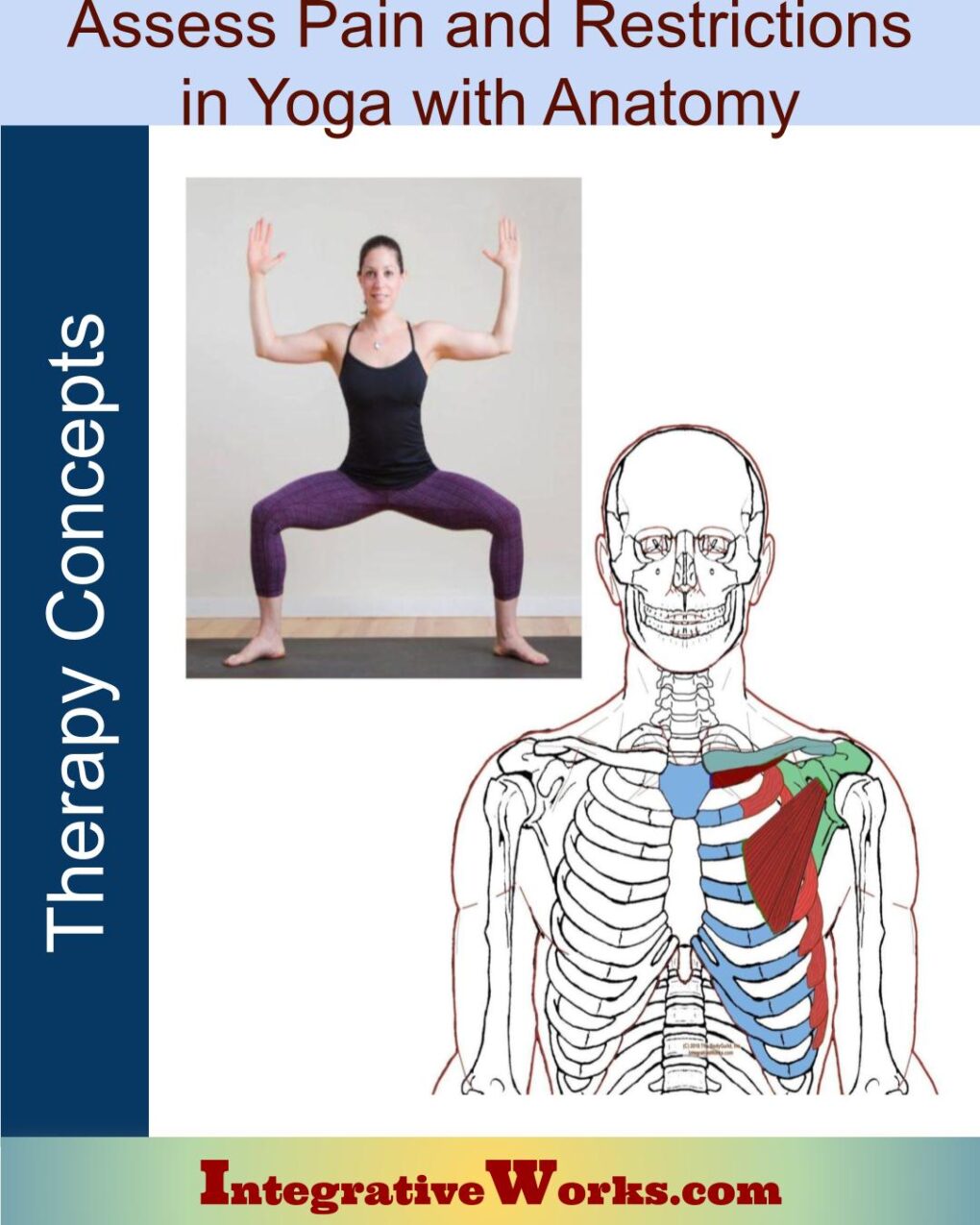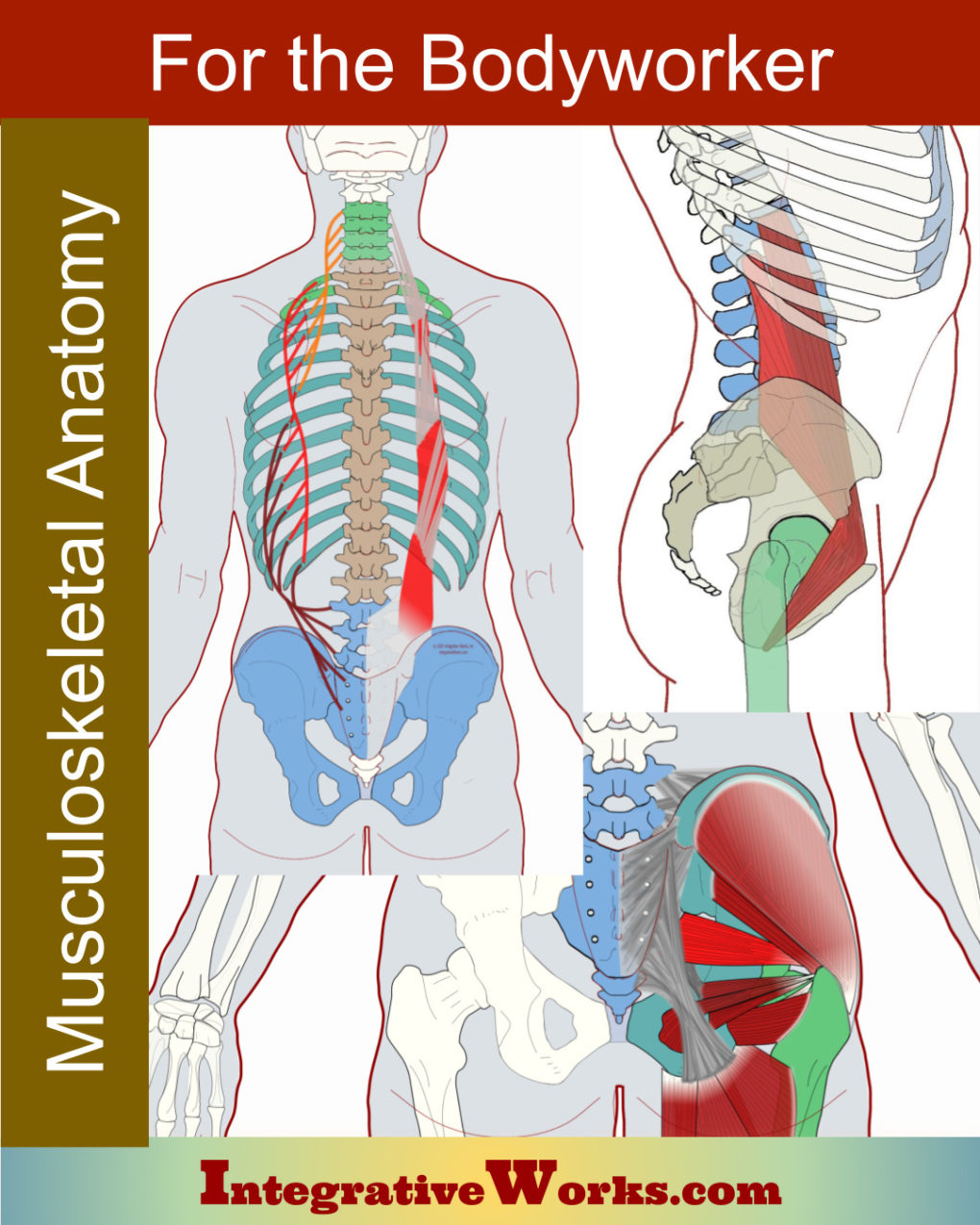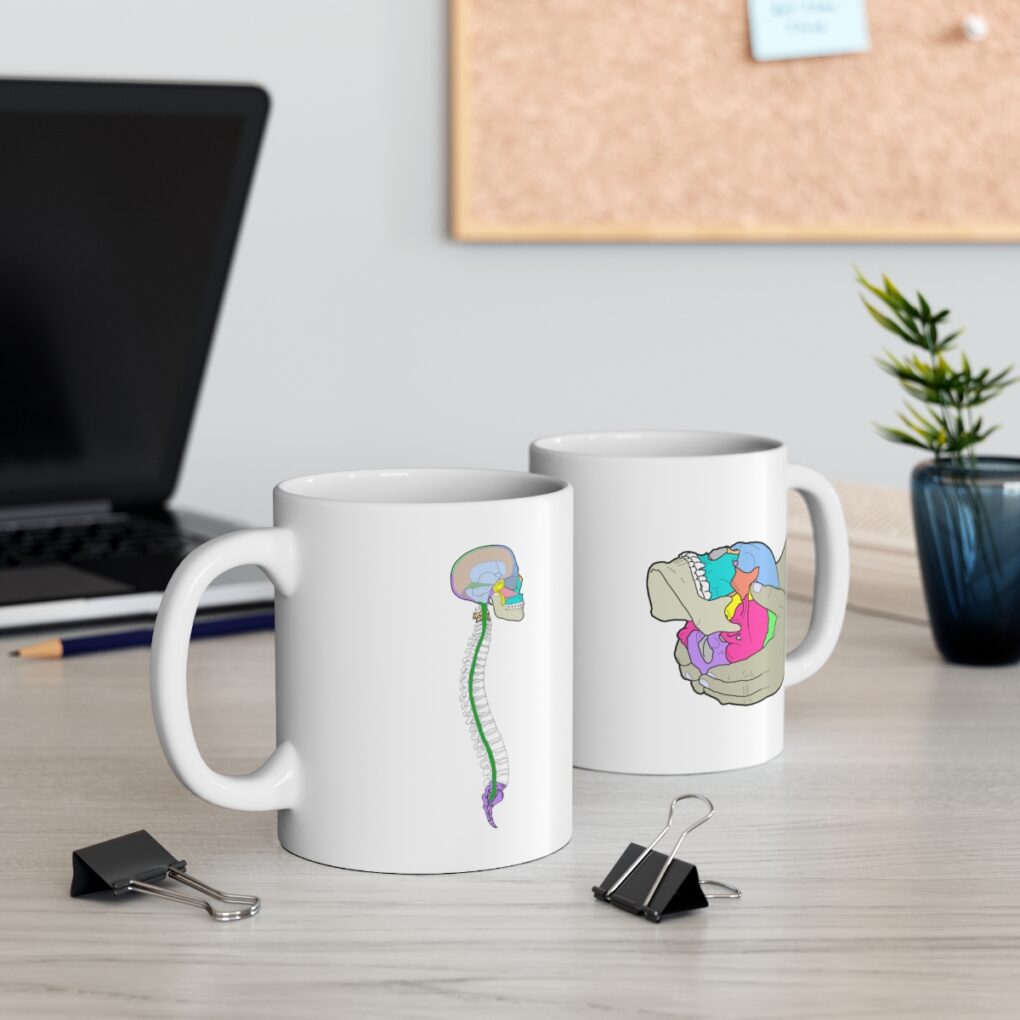Here, I discuss assessment of the muscle that is causing pain and restrictions in your yoga poses by understanding the underlying anatomy. I discuss several other posts that may be helpful in a deeper understanding of this particular problem, how to use these anatomy illustrations, and related patterns.
I am in the process of building an anatomy section for a quicker, more practical understanding of musculoskeletal anatomy and physiology. Additionally, I am expanding my posts on the origin, insertion, function, and trapped bones. When I talk to yoga teachers, the illustrations help them to understand the muscular restriction in a certain movement more easily.
I wrote about the basics of these illustrations in this post. Origin in blue. Insertion in green. Trapped in brown. Combinations in teal.
I’m Being Picky, On Purpose
Let me note that the people in these pics are doing a great job. The imbalances are small. If you’re not a bodyworker, you probably don’t see them until I point them out. None of us are completely symmetrical. I talk about that in another post. These people are pretty close and doing a great job. I’m just being picky for the assessment of yoga poses.
Here is an example to show you how these help yoga teachers and bodyworkers can evaluate their clients:
Assess the Imbalance in a Pose
A client came in with problems in her shoulder. She could not get the shoulder to retract (move back toward the spine) like the other shoulder. This happens in poses like the Goddess Squat. Also, she had a little pain in the front of the shoulder.
Okay, let’s track down the muscles that keep her from getting her shoulder back.
First of all, look closely at this pic. You’ll see that this woman’s left shoulder also does not retract as well as the right one. I wonder if hers hurts too. There are a lot of things that could hurt in this position, but trigger point assessment targets the problem. Trigger points produce predictable sensations on the stretch, but we don’t always need the trigger point info to figure this out, we can do it by just looking at the anatomy.
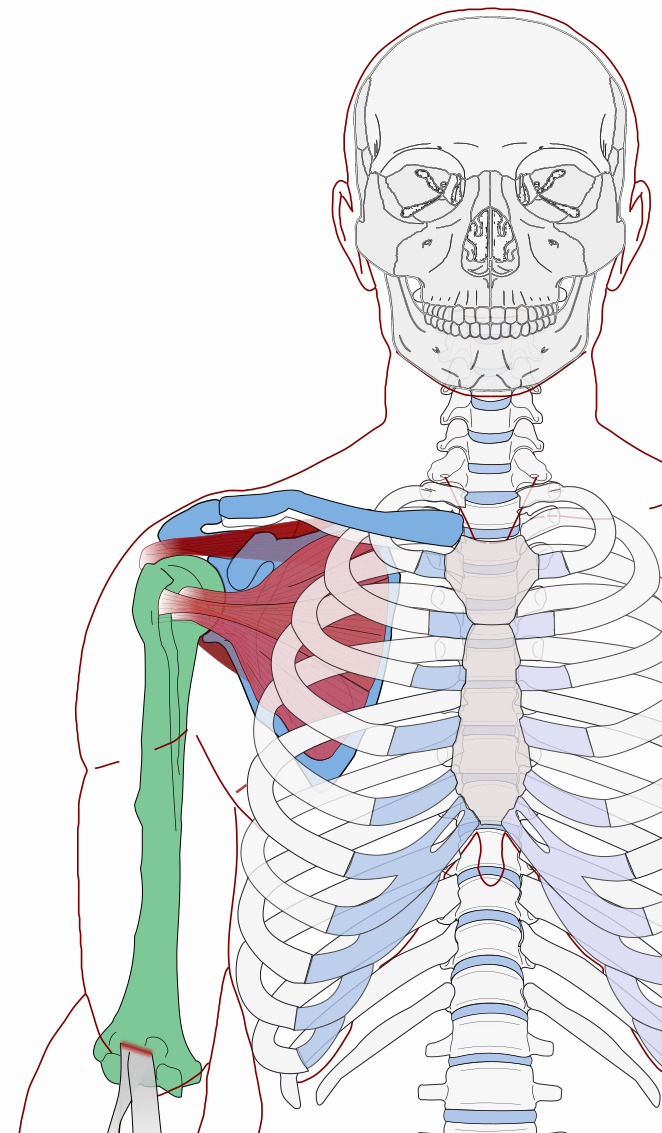
Not the Common Guess
Is it the rotator cuff? Everybody goes there when there’s a shoulder problem. If you click on the image to the left, you’ll see that the rotator cuff can create shoulder pain in this position.
This illustration shows that the rotator cuff muscles originate on the scapula and insert on the head of the humerus. They are all about securing the movement of the humeral head in the socket. Well, we can twist the arm in the socket and move it back and forth and up and down and the pain does not change.
However, it does hurt when we retract the shoulder blade and it just won’t go back as far as the other side. It is probably not the rotator cuff, which ties the humerus to the scapula. It is probably something that ties the shoulder to the ribs.
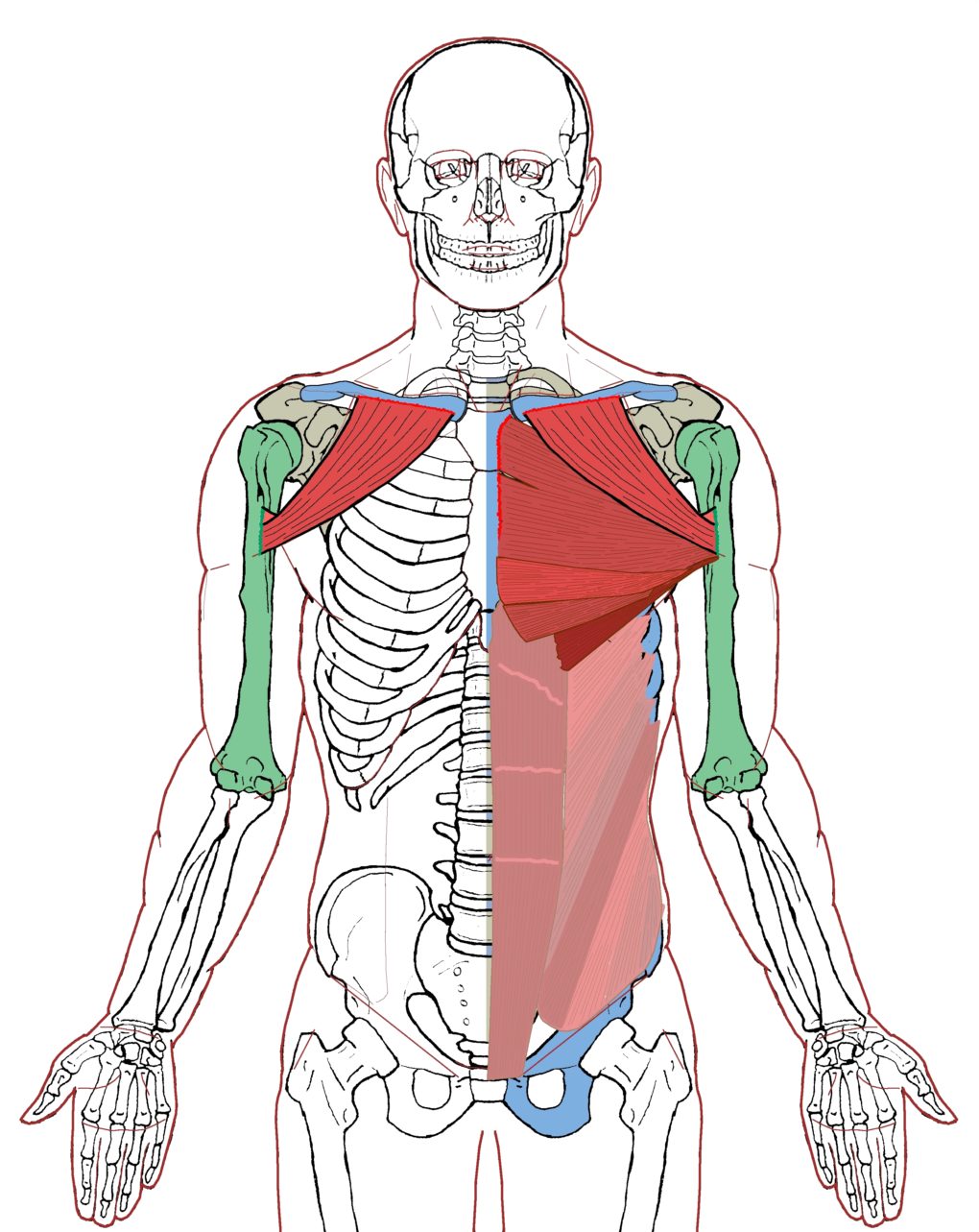
Narrowing it Down
Is it from the pain described in this post about the clavicular section of the pectoralis major? Pectoralis major attaches to the ribs and might be creating a restriction while taking that shoulder back.
Again, let’s look at the simple anatomy. If we take the elbow forward to shorten the clavicular pec, the scapula still doesn’t retract. So, it’s not the clavicular pec. It is about an attachment from the ribs to the scapula, not the ribs to the humerus.
By the way, the clavicular division can be stretched a little more by modifying the posture. We can move the elbow back or forward without moving the scapula. If there is no change in the pain, it probably isn’t any part of the pectoralis major, which attaches to the arm.
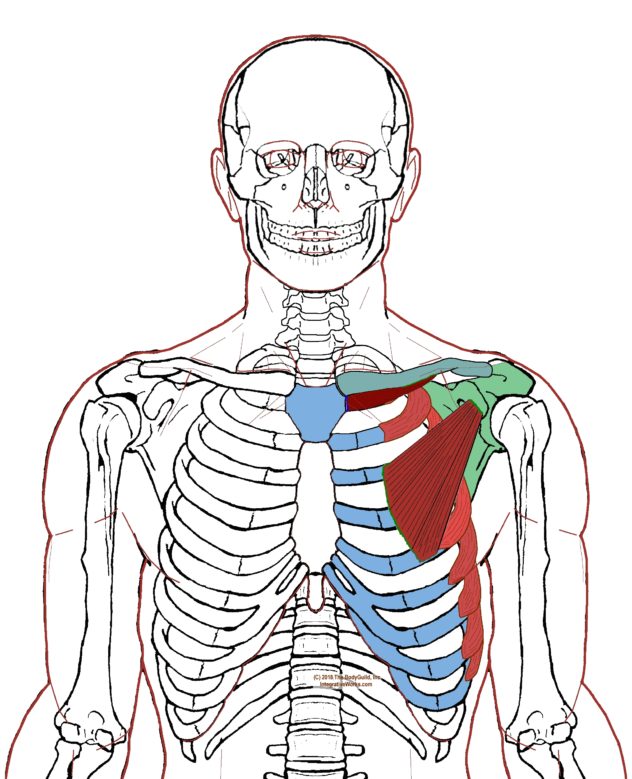
Targeting the Group
Something will not lengthen to allow the shoulder to retract. So, what else pulls the scapula forward?
Illustrations like this one show a group of related muscles. These are the deep extrinsic chest muscles. They originate on the anterior (front of the body) ribs and insert on the pectoral girdle. The serratus anterior and the pec minor trap the clavicle between the ribs and scapula.
We have quickly narrowed it down to this group. It is one of these three muscles; subclavius, pectoralis minor, or serratus anterior.
Assessment with Another Yoga Pose
It turns out to be pec minor. We can assess this when the person assumes a yoga pose on their back. Pec minor pulls the shoulder forward off the mat as you see in this serene beach version of yoga Nidra. The right shoulder doesn’t lay on the mat like his left. Again, he’s doing a great job. Of laying there. Meditatively. It may be subtle but look at the chest’s slope and the fold between the deltoid and pecs on the right. Classic pec minor. That rascal.
Helpful Posts
There are several posts that help with this concept, if youd like more depth:
- Pain in the Shoulder reviews all posts about pain in the shoulder
- Pectoralis Minor Anatomy reviews all related posts, including trigger point pain, self-care, therapy notes, and more.
- Pectoralis Major Anatomy reviews all the related posts, which often have very similar patterns to pectoralis minor
- Torso into Arm reviews patterns that, like pectoralis minor, refer from the torso and shoulder down the arm.
Heads Up
Anyway, there’s a heads-up on where these blog posts are headed. You’ll see many anatomy posts and the associated trigger point posts to allow people to assess postures. There will be some extra anatomy posts to match the trigger point posts that are already out there. They will be organized into groups by tags so that you can look at things like all the rotator cuff muscles or all the shoulder pain patterns to help you. If you’ve got a comment, suggestion, or see an error, send an email to me at the address below.
Support Integrative Works to
stay independent
and produce great content.
You can subscribe to our community on Patreon. You will get links to free content and access to exclusive content not seen on this site. In addition, we will be posting anatomy illustrations, treatment notes, and sections from our manuals not found on this site. Thank you so much for being so supportive.
Cranio Cradle Cup
This mug has classic, colorful illustrations of the craniosacral system and vault hold #3. It makes a great gift and conversation piece.
Tony Preston has a practice in Atlanta, Georgia, where he sees clients. He has written materials and instructed classes since the mid-90s. This includes anatomy, trigger points, cranial, and neuromuscular.
Question? Comment? Typo?
integrativeworks@gmail.com
Follow us on Instagram

*This site is undergoing significant changes. We are reformatting and expanding the posts to make them easier to read. The result will also be more accessible and include more patterns with better self-care. Meanwhile, there may be formatting, content presentation, and readability inconsistencies. Until we get older posts updated, please excuse our mess.

